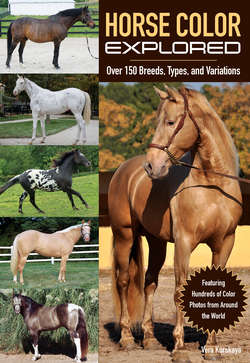Читать книгу Horse Economics - Vera Kurskaya - Страница 19
На сайте Литреса книга снята с продажи.
BLACK
ОглавлениеBlack color (Photo 1) is evident in the hair on the horse’s torso, head, legs, and also the mane and tail. The skin is dark gray, the eyes dark or hazelnut, the horn on hooves is pigmented, and the eyelashes are black. Faded black color usually develops under prolonged exposure to external factors such as excessive sunshine, harsh weather conditions, or increased sweating, but it may also develop spontaneously (Photo 2). The tips of faded black hair acquire a dirty-brown color, and the extent can vary. The head and legs of the faded black horse are always darker than the body, since the hair on these places is very short and less subjected to noticeable discoloration in comparison with longer hair on the body. In order to distinguish faded black from seal brown (see p. 12), it is necessary to look at the horse’s head, in particular the region around the muzzle and the eyes. If in these places the hair is reddish or dark brown, then the color is seal brown. Note: There are also so-called non-fading black horses but they are less common. Such horses do not become faded, even when exposed to the effects of external elements.
Black foals are usually born ashy color and the legs and stomach are lighter than the remaining areas of the body.
Black horses are less common than bay (see p. 12) or chestnut (see p. 13). This color is the preferred color in Friesians. Some breeds where black color is frequently encountered include: the Percheron, Shire, Russian Saddle Horse, Russian Trotter, Kabardin, Vladimir Heavy Draft, Karachai, and the Kladruber. At the same time, it is rare in other breeds—Arabians, for example.
